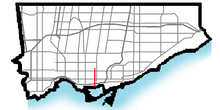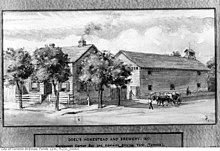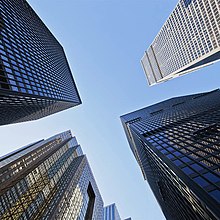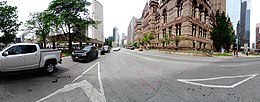Bay Street
 | |||||||||
|---|---|---|---|---|---|---|---|---|---|
 | |||||||||
| North end | Davenport Road | ||||||||
| South end | Lake Ontario | ||||||||
| |||||||||
Bay Street is a major thoroughfare in Downtown Toronto, Ontario, Canada. It is the centre of Toronto's Financial District and is often used by metonymy to refer to Canada's financial services industry since succeeding Montreal's St. James Street in that role in the 1970s.
Bay Street begins at
History

The street was originally known as Bear Street because of frequent bear sightings in the early history of Toronto.
Until 1922, the section of Bay running north from Queen Street and ending at College Street was known as Terauley Street (named after the Terauley estate of John Simcoe Macaulay near Bay and Queen Streets). Several discontinuous streets existed north of College Street to Davenport Road - St. Vincent Street, Chapel Street, North Street, Ketchum Avenue. By-Law 9316 joined these streets together as far north as Scollard Street in 1922.[3] Finally, By-Law 9884, enacted on January 28, 1924, changed the name of Ketchum Avenue to Bay Street, extending it to Davenport Road.[4] There is a short street called Terauley Lane running west of Bay from Grenville Street to Grosvenor Street.
Finance district

"Bay Street" is frequently used as a metonym to refer to Toronto's Financial District and the Canadian financial sector as a whole, similar to Wall Street in the United States. "Bay Street banker", as in the phrase "cold as a Bay Street banker's heart", was a term of opprobrium especially among Prairie farmers who feared that Toronto-based financial interests were hurting them.[5] Within the legal profession, the term Bay Street is also used colloquially to refer to the large, full-service business law firms of Toronto.
The intersection of Bay and King Street is often seen as the centre of Canadian banking and finance. Four of Canada's five major banks have office towers at the intersection — the Bank of Montreal at First Canadian Place, Scotiabank at Scotia Plaza, the Canadian Imperial Bank of Commerce (CIBC) at Commerce Court, and Toronto-Dominion Bank at the Toronto-Dominion Centre — and the fifth, the Royal Bank at Royal Bank Plaza, is one block south. Historically, Bay and King was known as the "MINT Corner" from Montreal, Imperial, Nova Scotia, and Toronto, but since 1961 the Imperial Bank has been part of CIBC and the Bank of Nova Scotia has rebranded itself, so this nickname is no longer widely used. The core cluster of towers has crept north with the addition of the 50-storey Bay Adelaide Centre and the St. Regis Hotel.
Points of interest

The
Significant
The area attracts many who work in the financial district and those who work in the Discovery District, nearby hospitals and schools (Toronto Metropolitan University and the University of Toronto). More than 67 per cent (or 10,380) of residents in this area are in the working ages of 25-64, significantly higher than the City of Toronto's average of 58%.[6]
Notable buildings include:

- St. Basil's Church (Toronto)
- Toronto Coach Terminal
- Residences of College Park
- 777 Bay
- Murano
- Ontario Government Buildings
- Sutton Place Hotel
- Manulife Centre
- Nathan Phillips Square
- Flagship store of Hudson's Bay Company
Public transit
Bay Street is served by the
See also
References
- ^ City of Toronto Archives, Bay Street index card
- ^ Peppiatt, Liam. "Chapter 19: A Sketch of the Grange". Robertson's Landmarks of Toronto Revisited. Archived from the original on 2018-09-27. Retrieved 2015-07-11.
- ^ City of Toronto. By-Law No. 9316. "Appendix 'B'" to the Minutes of Proceedings to the Council of the Corporation for the City of Toronto for the year 1922: Volume Two. Toronto: The Carswell Co. 1922. p. 589.
- ^ City of Toronto. By-Law No. 9884. "Appendix 'B'" to the Minutes of Proceedings to the Council of the Corporation for the City of Toronto for the year 1924: Volume Two. Toronto: The Carswell Co. 1924.
- ISBN 9780203962114.
- ^ Gender and Age
- ^ James Bow (November 10, 2006). "The Dupont and Bay Streetcars (Deceased)". Transit Toronto. Retrieved September 22, 2012.
